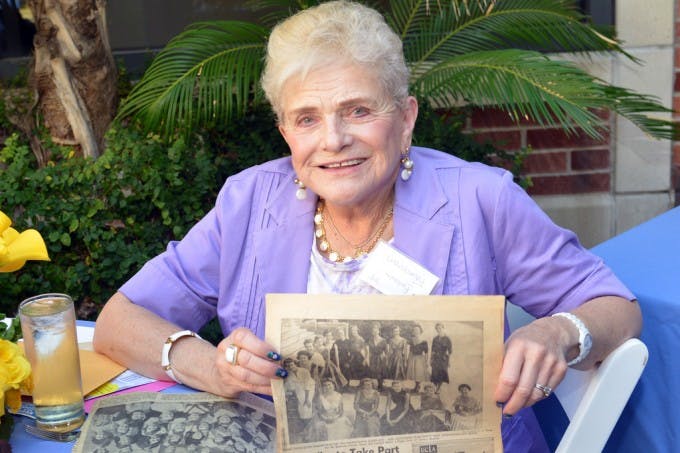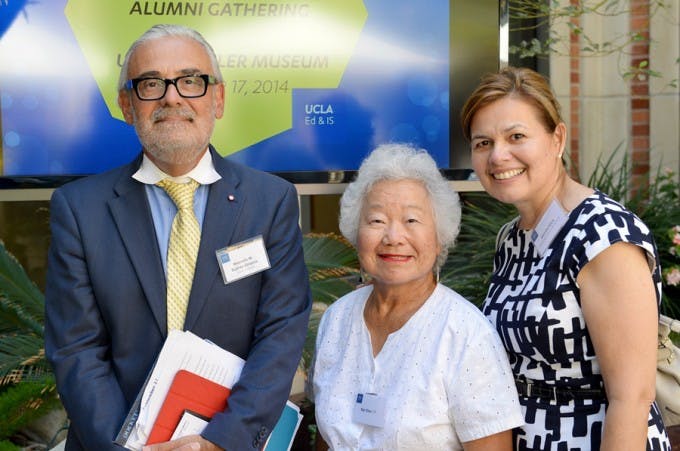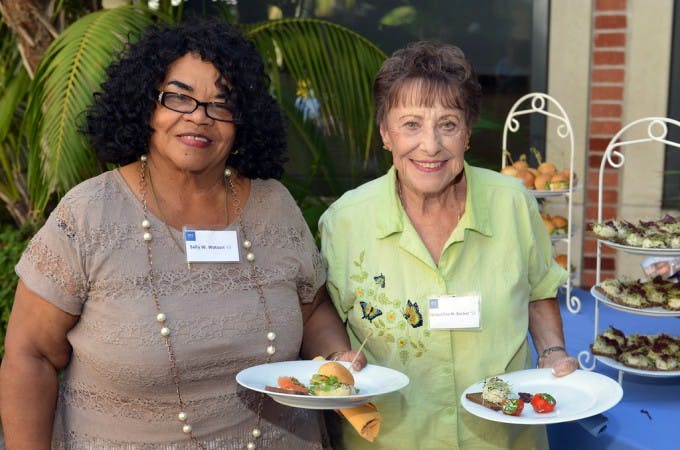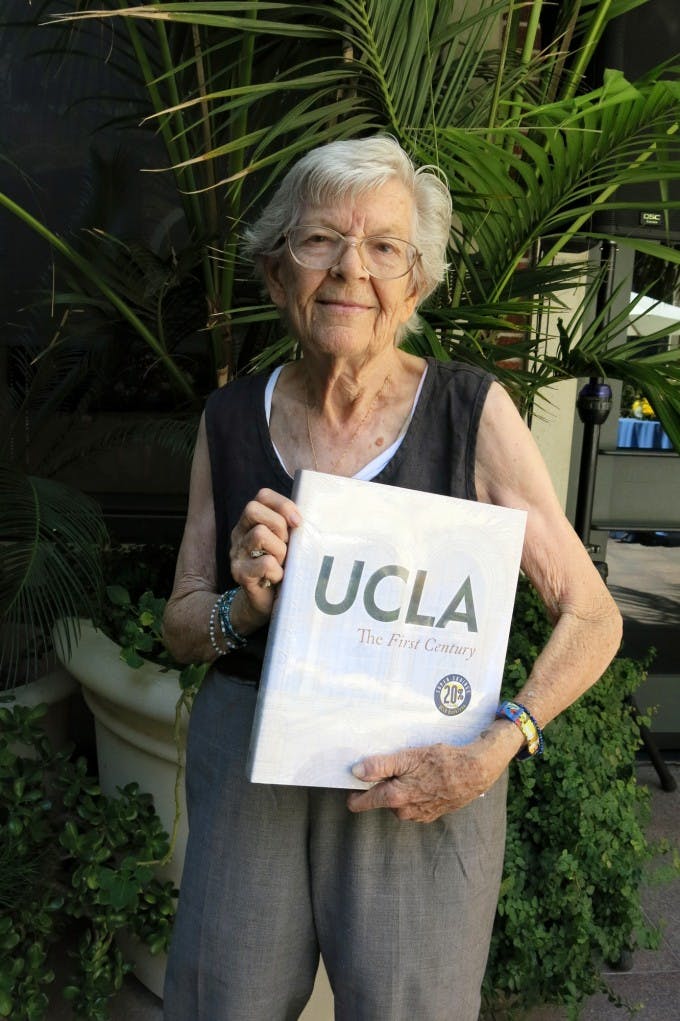UCLA Education and Library Science alumni from the Classes of 1940 through 1969 celebrated their time on campus at a reception on Sept. 17 at the Fowler Museum. Along with photos and memorabilia from their Bruin days, guests brought donations of books for UCLA Community School.
Qiana Moore, assistant director of Stewardship & Donor Events, welcomed guests to the Fowler Museum Courtyard, and started the program with a showing of the “Let There Be…” video for the UCLA Centennial Campaign. Norma Silva, principal of UCLA Lab School and UCLA Ed & IS Dean Marcelo Suárez-Orozco, were featured speakers.
A social hour connected UCLA alumni from the earliest days of the UCLA School of Education and the UCLA School of Library Science. Morton Miller (’56, Education), who currently teaches mathematics at Ohr Eliyahu Academy in Los Angeles, recalled his time on campus as “great,” but noted that, “The hard part was getting in.”
“In 1946, there was no mail registration, so you had to line up all night on Westwood Boulevard and run for classes,” says Miller, remembering the experience of standing in line with his fellow returning WWII veterans. “And if you didn’t run fast enough, you didn’t get your classes. I started in line at probably 10 or 11 o’clock at night, and remember that at 2:00 in the morning, my parents came by with coffee and sandwiches.”
Barbara Faierman’s (’55, Education) memories of her time at UCLA were slightly more glamorous. The mother of two UCLA alumnae shared clippings from the Daily Bruin, as well as her personal photos of campus activities, which included her making it to the final selection round for Homecoming Court.
“I was taken to the Bel Air Hotel for lunch, it was very nice,” said Faierman, who grew up in Los Angeles and taught at Beverly Vista School in Beverly Hills. “Kim Novak was one of the judges, believe it or not.”

Silva visited with alumni and found that many of them had done their student teaching at UCLA Lab School – in those days, known as University Elementary School or UES. She paid tribute to Corrine A. Seeds, UES’s founding principal, and to Madeleine Hunter, who was UES principal from 1963 to 1982, and to the inspiration both educators drew from educational reformer John Dewey.
“Our pedagogy today is rooted in the work of these great educators,” said Silva. “As a laboratory school, we are examining and responding to today’s contexts, both locally and globally. It’s an exciting and motivating part of being a laboratory school, to have researchers at our school who we can collaborate with, who we can ask questions, and share our struggles and concerns.”
Silva discussed several of the many research initiatives and teacher education experiences at UCLA Lab School, including its integral role in UCLA’s Teacher Education Program (TEP), the “Safe School” conflict resolution model, and the CONNECT Program, UCLA Lab School’s research collaboration with UCLA Ed & IS and schools throughout Southern California.

“We’re working on creating an educational experience that has coherence, consistency, and progression across the school,” said Silva. “At UCLA Lab School, teachers listen to children’s ideas and concerns as we progress through interdisciplinary inquiry. We seek to engage in inquiry that supports them in understanding and unpacking the complexity of the world, and we explore ideas and concepts through multiple perspectives and multiple lenses that help children gain a deeper understanding of their world and prepare them for their roles in that world through inquiry projects… projects that are relevant to students and that will help us to plant the seeds of activism and service to others while also fostering a real sense of agency.”
Dean Suárez-Orozco recalled UCLA’s origins as the Southern Branch of University of California, Berkeley, established in 1882 as the State Normal School and the nucleus for “the only major research university in our country and in the world that began with a teachers’ college and a small laboratory school.” He underscored the significance of education as both UCLA’s heritage and its future, as depicted in the “Let There Be…” campaign video.

“It is very clear that two schools at UCLA are in the business of making miracles: the Geffen School of Medicine and the Graduate School of Education & Information Studies,” said Suárez-Orozco. “There are endless possibilities for our students and faculty as they come through our campus. The upcoming Centennial Campaign really begins the process of reimagining our next century together.”
Suárez-Orozco shared some of the most transformational news about UCLA Ed & IS’s laboratory schools. He described the current renovations and improvements taking place at UCLA Lab School as in keeping with the vision of architect Richard Neutra, who designed the original buildings in the mid-1950s.
“These are historic buildings,” he said. “Many of you spent time at the original Neutra [campus]. We’re working extremely hard to keep the spirit of the Neutra view and understanding of children, of learning, of teaching, of engagement.”

Suárez-Orozco also highlighted the unprecedented 95 percent of college-bound graduates from UCLA Community School this year, members of the first full four-year high school cohort.
“We’re fundamentally moving the needle in urban education in our country today,” he noted. “Five students got into UCLA, the most applied-to university in the world. We got more kids from UCLA Community School into UCLA, into Berkeley, into UC San Diego – you name it – than ever before.”
Suárez-Orozco also highlighted current and upcoming initiatives for UCLA Ed & IS, including the gathering of experts from across the UCLA campus for a cohort of “senior researchers and new professors… to partner with UCLA Medical School to create a transformational center to look at what the new science of the brain can tell us about cognitive and metacognitive development, socioemotional development, and learning for all our children. There are extraordinary, really transformational opportunities today in the emerging field of mind, brain, and learning, and I believe that UCLA is poised to be at the very center of this new emerging field.”
Suárez-Orozco discussed bringing teacher education into the digital era in order to better serve the new generation of “digital native” children in schools, and of education for students of color and immigrants as another focus of his deanship. He spoke of the Graduate School’s commitment to understanding and educating today’s diversity with the transformational research being done by the Black Male Institute and the Institute for Immigration, Globalization, and Education, among many others at UCLA Ed & IS.
“John Dewey understood the nexus between education and citizenship,” observed Suárez-Orozco. “You can’t have a free people capable of self-governing without a robust public education system for all our children. And in this, the hyper-diversity of the 21 Century – we need to be at the forefront in engaging all children – children of color – with the five E’s of education in the 21 Century: Excellence, deep Engagement, an Ethical core, a sense of Equity for an Education for all.
“I arrived in this country when I was 17. I spoke little English and went to night school and community college. I transferred to the great University of California – I’m a product of Clark Kerr and the California Master Plan. Fifteen years after I graduated from Berkeley, I was inducted into one of the oldest and most prestigious chairs at Harvard University. So I believe that in the context of the extraordinary demographic change taking place in our country, we need to redouble our efforts to improve opportunities for all children, especially children of color, Black children, children of immigrants, English language learners – all children. At UCLA, education is both history and destiny. The new Bruin century will renew our commitment to excellence, to equity, to an ethical education that serves the purpose of a democracy in the 21 Century.”
For more photos of the Education and Library Science Alumni Tea, click here.
